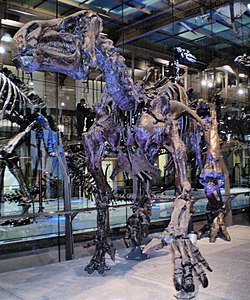Iguanadon
|
Iguanodon Temporal range: Early Cretaceous, 126–125 Ma |
|
|---|---|
 |
|
| I. bernissartensis mounted in modern quadrupedal posture, Royal Belgian Institute of Natural Sciences, Brussels | |
| Scientific classification | |
| Kingdom: | Animalia |
| Phylum: | Chordata |
| Class: | Reptilia |
| Clade: | Dinosauria |
| Order: | †Ornithischia |
| Suborder: | †Ornithopoda |
| Clade: | †Hadrosauriformes |
| Genus: |
†Iguanodon Mantell, 1825 |
| Type species | |
|
†Iguanodon bernissartensis Boulenger, 1881 |
|
| Species | |
|
†I. bernissartensis Boulenger, 1881 |
|
| Synonyms | |
|
Delapparentia turolensis Ruiz-Omeñaca, 2011 |
|
†I. bernissartensis Boulenger, 1881
†I. galvensis Verdú et al., 2015
†I. ottingeri? Galton and Jensen, 1979
Delapparentia turolensis Ruiz-Omeñaca, 2011
Iguanosaurus? Ritgen, 1828
Hikanodon? Keferstein, 1834
Iguanodon (/ᵻˈɡwɑːnədɒn/ i-GWAH-nə-don; meaning "iguana-tooth") is a genus of ornithopod dinosaur that existed roughly halfway between the first of the swift bipedal hypsilophodontids of the mid-Jurassic and the duck-billed dinosaurs of the late Cretaceous. While many species have been classified in the genus Iguanodon, dating from the late Jurassic Period to the early Cretaceous Period of Asia, Europe, and North America, research in the first decade of the 21st century suggests that there is only one well-substantiated species: I. bernissartensis, which lived from the late Barremian to the earliest Aptian ages (Early Cretaceous) in Belgium, Spain, and possibly elsewhere in Europe, between about 126 and 125 million years ago. Iguanodon were large, bulky herbivores. Distinctive features include large thumb spikes, which were possibly used for defense against predators, combined with long prehensile fifth fingers able to forage for food.
...
Wikipedia
